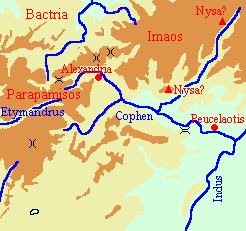Andrew Hall
Middle School Social Studies
Community Day Charter School, Lawrence, MA
Home
|
History
of Gandhara
|
 Gandhara
is strategically situated along major trade routes linking India, China,
Tibet and Western Asia. Some Eastern European countries also had direct
and indirect contact with the region. This intersection of cultures also
brought a host of different conquerors and rulers over the centuries.
Gandhara
is strategically situated along major trade routes linking India, China,
Tibet and Western Asia. Some Eastern European countries also had direct
and indirect contact with the region. This intersection of cultures also
brought a host of different conquerors and rulers over the centuries.
Gandhara was
dominated from the 6th to 4th centuries BC by the Achaemenid Dynasty of
Iran.  Alexander
the Great led his conquering army through the region around 330 BC
and established Greek outposts in the region. With Alexander came settlers,
traders, craftsmen and Hellenistic culture. The influence of this Hellenization
persisted for centuries but the Greek outposts were eventually overrun
by indigenous nomadic peoples.
Alexander
the Great led his conquering army through the region around 330 BC
and established Greek outposts in the region. With Alexander came settlers,
traders, craftsmen and Hellenistic culture. The influence of this Hellenization
persisted for centuries but the Greek outposts were eventually overrun
by indigenous nomadic peoples.
Buddhism arrived
in the region resulting from the  intense
missionary activities of the Emperor
Ashoka (273-232 BC). Ashoka, informally known to western audiences
as the "Buddhist Constantine", established Buddhism as the state
religion in his kingdom. Ashoka is known for encouraging the conversion
of large areas of India, Pakistan, Afghanistan and other regions to Buddhism.
intense
missionary activities of the Emperor
Ashoka (273-232 BC). Ashoka, informally known to western audiences
as the "Buddhist Constantine", established Buddhism as the state
religion in his kingdom. Ashoka is known for encouraging the conversion
of large areas of India, Pakistan, Afghanistan and other regions to Buddhism.
 Ashoka
built large shrines, monasteries and other images in the name of Buddhism.
Gandhara was an area that embraced Buddhism and began to pioneer the iconographic
tradition that is prevalent throughout the Buddhist world. Gandharan artisans
were the first Buddhists to portray the Buddha in human form, not just
in symbolic iconography that was used up to this point.
Ashoka
built large shrines, monasteries and other images in the name of Buddhism.
Gandhara was an area that embraced Buddhism and began to pioneer the iconographic
tradition that is prevalent throughout the Buddhist world. Gandharan artisans
were the first Buddhists to portray the Buddha in human form, not just
in symbolic iconography that was used up to this point.
Images of Buddha's, Bodhisattva's and other Buddhist representations began to emerge from the region and the Gandharan School of Art began to expand its sphere of cultural influence. The cities of Taxila, and Peshawar were famous for their Greco-Indian Buddhist art.
The Gandhara school incorporated many motifs and techniques from classical Roman art, including vine scrolls, cherubs bearing garlands, tritons, and centaurs. And yet, what singled this form out was its strict adherence to the basic Indian iconographic details. Interestingly, this is a remarkable feature of the Buddhist art throughout the continent. It incorporates local elements to fuse into the local culture.
 The
standing Buddha is an example of the success of the Gandharan School.
Buddha's face takes on features closely resembling the images of Apollo
in the Greek and Roman world. His robes resemble that of a Greek or Roman
statesman. The figure on the right, made around the 2nd century shows
a Gandharan style Standing Buddha figure.
The
standing Buddha is an example of the success of the Gandharan School.
Buddha's face takes on features closely resembling the images of Apollo
in the Greek and Roman world. His robes resemble that of a Greek or Roman
statesman. The figure on the right, made around the 2nd century shows
a Gandharan style Standing Buddha figure.
With the subsequent waning of Buddhism in the region as well as the arrival of the White Huns in the 5th century AD, Buddhism began to lose its grip on the region. The area became Islamicised and the Gandharan Art school ceased to produce Buddhist works of art.
Gandhara has taken it's place in history as one of the most important and influential regions in the formation of Buddhism as a major world religion. The first Indian Buddhist texts that have been discovered are from Gandhara. Mahayana Buddhism, a later reform movement is said to have its origins in Gandhara. Padmasanbhava, one of the early founders of Tibetan Buddhism is supposed to have been born in the Gandharan region. It is Buddhist art that owes an incredible debt to the Gandharan school and the visual reminders of Gandharan influence still remain.
This site was created by .... at the NEH Summer Institute "Cultures and Religions of the Himalayan Region," held at the College of the Holy Cross, Summer 2004